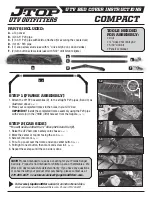
NOTE:
Intentional tampering with the emissions control system
can result in civil penalties being assessed against you.
CARBON MONOXIDE WARNINGS
WARNING!
Carbon monoxide (CO) in exhaust gases is deadly.
Follow the precautions below to prevent carbon mon-
oxide poisoning:
•
Do not inhale exhaust gases. They contain carbon
monoxide, a colorless and odorless gas, which can
kill. Never run the engine in a closed area, such as
a garage, and never sit in a parked vehicle with the
engine running for an extended period. If the
vehicle is stopped in an open area with the engine
running for more than a short period, adjust the
ventilation system to force fresh, outside air into
the vehicle.
•
Guard against carbon monoxide with proper main-
tenance. Have the exhaust system inspected every
time the vehicle is raised. Have any abnormal con-
ditions repaired promptly. Until repaired, drive with
all side windows fully open.
FUEL REQUIREMENTS – DIESEL ENGINE
Use good quality diesel fuel from a reputable supplier in
your vehicle. Federal law requires that you must fuel
this vehicle with Ultra Low Sulfur Highway Diesel fuel
(15 ppm Sulfur maximum) and prohibits the use of Low
Sulfur Highway Diesel fuel (500 ppm Sulfur maximum)
to avoid damage to the emissions control system.
For most year-round service, No. 2 diesel fuel meeting
ASTM (formerly known as the American Society for Test-
ing and Materials) specification D-975 Grade S15 will
provide good performance. If the vehicle is exposed to
extreme cold (below 20°F or -7°C), or is required to
operate at colder-than-normal conditions for prolonged
periods, use climatized No. 2 diesel fuel or dilute the
No. 2 diesel fuel with 50% No. 1 diesel fuel. This will
provide better protection from fuel gelling or wax-
plugging of the fuel filters.
WARNING!
Do not use alcohol or gasoline as a fuel blending
agent. They can be unstable under certain conditions
and hazardous or explosive when mixed with diesel
fuel.
Diesel fuel is seldom completely free of water. To pre-
vent fuel system trouble, drain the accumulated water
from the fuel/water separator using the fuel/water
separator drain provided on both fuel filters. If you buy
good quality fuel and follow the cold weather advice
above, fuel conditioners should not be required in your
vehicle. If available in your area, a high cetane “pre-
mium” diesel fuel may offer improved cold-starting and
warm-up performance.
CAUTION!
If the “Water in Fuel Indicator Light” remains on, DO
NOT START engine before you drain the water from
the fuel filter(s) to avoid engine damage. Refer to
“Draining Fuel/Water Separator Filter” in “Servicing
And Maintenance” for further information.
FUEL SPECIFICATIONS
The Cummins® Turbo Diesel engine has been devel-
oped to take advantage of the high energy content and
generally lower cost No. 2 Ultra Low Sulfur diesel fuel or
No. 2 Ultra Low Sulfur climatized diesel fuels. Experi-
ence has shown that it also operates on No. 1 Ultra Low
Sulfur diesel fuels or other fuels within specification.
NOTE:
•
If you accidentally fill the fuel tank with gasoline on
your diesel vehicle, do not start the vehicle. If you
restart your vehicle you risk damaging the engine
and fuel system. Please call an authorized dealer for
service.
•
A maximum blend of 5% biodiesel meeting ASTM
specification D-975 may be used with your
Cummins® diesel engine. (Chassis Cab models not
configured with B20 capability.)
•
A maximum blend of 20% biodiesel meeting ASTM
specification D-7467 may be used with your
Cummins® diesel engine. (Pickup models and Chas-
sis Cab models configured with B20 Capability.)
•
In addition, commercially available fuel additives are
not necessary for the proper operation of your
Cummins® diesel engine. However, if seasonably
adjusted fuel is not available and you are operating
below 20°F (-6°C), Mopar® Premium Diesel Fuel
Treatment (or equivalent) may be beneficial to avoid
fuel gelling.
•
No. 1 Ultra Low Sulfur diesel fuel should only be
used where extended arctic conditions
(0°F or -18°C) exist.
TECHNICAL SPECIFICATIONS
333
8
















































